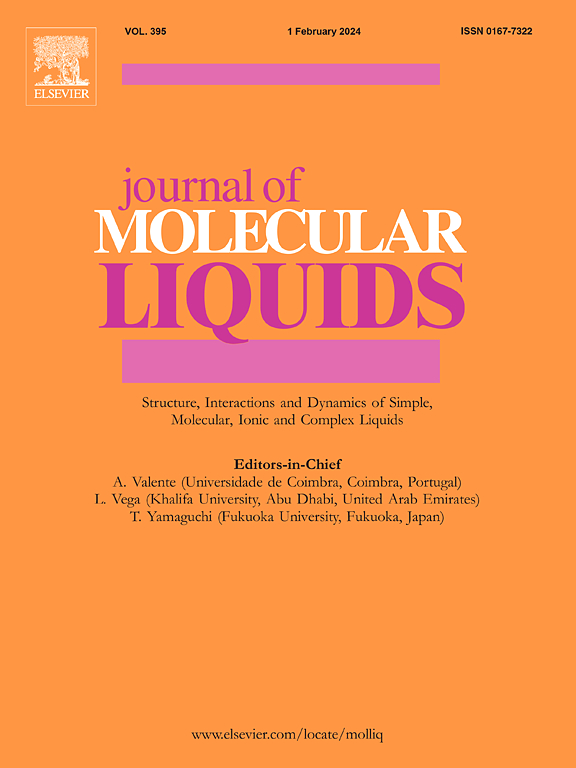Synthesis of highly stable Fe2O3-TiO2 Polysulfone membrane with solar light induced photocatalytic activation of peroxymonosulfate and self-cleaning properties
IF 5.3
2区 化学
Q2 CHEMISTRY, PHYSICAL
引用次数: 0
Abstract
In this study, high stable TiO2-Fe2O3 incorporated polysulfone (MFT) membranes were fabricated by phase inversion technique. This research significantly investigated the photocatalytic performance of the synthesized membranes for the degradation of a textile dye Rhodamine-B (RhB), both under the dark and solar irradiation. The addition of 0.15 wt% TiO2 and 0.15 wt% Fe2O3 as co-doped to the PSF membrane produced remarkable findings. Scanning electron microscopy (SEM) and x-ray diffraction (XRD) spectroscopy endorsed that TiO2 and Fe2O3 were uniformly dispersed on the synthesized membrane's surface. The synthesized membrane demonstrated the effective adsorption of RhB dye under dark and exhibited 95.7 % degradation of RhB via solar light. The degradation efficacy of RhB was further enhanced to 97 % with the addition of peroxymonosulfate (HSO5−) against the degradation of RhB. Furthermore, the synthesized membrane has proven continued enhancements in photocatalytic degradation and reusability. Furthermore, the experiments confirming the involvement of free radicals in the degradation process showed that the photo-degradation was predominantly driven by •OH and SO4•–. Moreover, under solar light, the synthesized membrane proven 86 % outstanding rejection of RhB and rapid photocatalytic self-cleaning capabilities. The MFT membrane has an apparent porosity of about 74.32 % and an average pore size of 0.048 μm. The resulting degradation of products and the corresponding toxicity evaluation indicated that the proposed system is environmentally friendly and cost effective in nature. This work presents a highly active nanocomposite membrane towards degradation of organic pollutants with self-cleaning properties effective recyclability.

高稳定Fe2O3-TiO2聚砜膜的合成及其光催化活化和自清洁性能
本研究采用相转化技术制备了高稳定性的TiO2-Fe2O3掺杂聚砜(MFT)膜。本研究主要考察了合成膜在黑暗和太阳照射下对纺织染料罗丹明- b (Rhodamine-B, RhB)的光催化降解性能。在PSF膜中加入0.15 wt%的TiO2和0.15 wt%的Fe2O3共掺杂,得到了显著的结果。扫描电镜(SEM)和x射线衍射(XRD)分析结果表明,TiO2和Fe2O3均匀分布在合成膜表面。合成的膜在黑暗条件下对RhB染料有较好的吸附效果,在日光下对RhB的降解率达到95.7%。添加过氧单硫酸根(HSO5−)对RhB的降解效果进一步提高到97%。此外,合成的膜在光催化降解和可重复使用方面得到了持续的增强。此外,证实自由基参与降解过程的实验表明,光降解主要由•OH和SO4•-驱动。此外,在太阳光照下,合成的膜具有86%的优异的RhB去除率和快速的光催化自清洁能力。MFT膜的表观孔隙率约为74.32%,平均孔径为0.048 μm。产物的降解和相应的毒性评价表明,所提出的系统是环境友好的,具有成本效益。本研究提出了一种高效的纳米复合膜,用于降解有机污染物,具有自清洁特性和有效的可回收性。
本文章由计算机程序翻译,如有差异,请以英文原文为准。
求助全文
约1分钟内获得全文
求助全文
来源期刊

Journal of Molecular Liquids
化学-物理:原子、分子和化学物理
CiteScore
10.30
自引率
16.70%
发文量
2597
审稿时长
78 days
期刊介绍:
The journal includes papers in the following areas:
– Simple organic liquids and mixtures
– Ionic liquids
– Surfactant solutions (including micelles and vesicles) and liquid interfaces
– Colloidal solutions and nanoparticles
– Thermotropic and lyotropic liquid crystals
– Ferrofluids
– Water, aqueous solutions and other hydrogen-bonded liquids
– Lubricants, polymer solutions and melts
– Molten metals and salts
– Phase transitions and critical phenomena in liquids and confined fluids
– Self assembly in complex liquids.– Biomolecules in solution
The emphasis is on the molecular (or microscopic) understanding of particular liquids or liquid systems, especially concerning structure, dynamics and intermolecular forces. The experimental techniques used may include:
– Conventional spectroscopy (mid-IR and far-IR, Raman, NMR, etc.)
– Non-linear optics and time resolved spectroscopy (psec, fsec, asec, ISRS, etc.)
– Light scattering (Rayleigh, Brillouin, PCS, etc.)
– Dielectric relaxation
– X-ray and neutron scattering and diffraction.
Experimental studies, computer simulations (MD or MC) and analytical theory will be considered for publication; papers just reporting experimental results that do not contribute to the understanding of the fundamentals of molecular and ionic liquids will not be accepted. Only papers of a non-routine nature and advancing the field will be considered for publication.
 求助内容:
求助内容: 应助结果提醒方式:
应助结果提醒方式:


